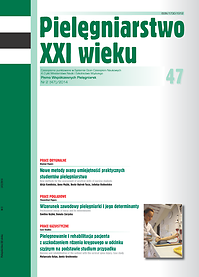New methods for the assessment of practical skills of nursing students
DOI:
https://doi.org/10.12923/Keywords:
nursing, learning outcomes, OSCEAbstract
NEW METHODS FOR THE ASSESSMENT OF PRACTICAL SKILLS OF NURSING STUDENTS
Aim. The aim of this study was to evaluate the implementation of a new method of assessment of learning outcomes for nursing students – a shortened OSCE as part of the classes in Fundamentals of Nursing.
Materials and methods. The study involved 298 students at their first year of full-time studies of 1st degree in Nursing at INM JU MC in Kraków. The study was performed twice at the end of the course in the skills laboratory: in January and April 2013. The course was credited by means of a shortened OSCE. That method formatted (shaped) the evaluation of the learning outcomes. After the examination, students filled in an evaluation questionnaire. The study used the method of diagnostic survey, the technique of survey questionnaire, and the research tool of proprietary evaluation survey questionnaire.
Results. The method was highly praised by the majority of students as useful in the development of intellectual, practical and affective skills. In the students’ opinion, examination in the form of mini-OSCE should be evaluated favorably both in terms of content and organization. It scored high and very high in the majority of categories.
Conclusions. According to the authors’ research, the scope of evaluation requires broadening and OSCE session needs multiple repetitions. The preliminary results obtained can be regarded as an attempt to objectify the new method in order to verify the effects of education among nursing students.
References
1. Ustawa z dnia 18 marca 2011 r. o zmianie ustawy – Prawo o szkolnictwie wyższym, ustawy o stopniach naukowych i tytule naukowym oraz o stopniach i tytule w zakresie sztuki oraz o zmianie niektórych innych ustaw. Dz. U. z 2011 nr 84, poz. 455.
2. Rozporządzenie Ministra Nauki i Szkolnictwa Wyższego z dnia 2 listopada 2011 r. w sprawie Krajowych Ram Kwalifikacyjnych dla Szkolnictwa Wyższego. Dz. U. z 2011 nr 253, poz. 1520.
3. Rozporządzenie Ministra Nauki i Szkolnictwa Wyższego z dnia 4 listopada 2011 r. w sprawie wzorcowych efektów kształcenia. Dz. U. z 2011 nr 253, poz. 1521.
4. Chmielecka E. red. Autonomia programowa uczelni – ramy kwalifikacji dla szkolnictwa wyższego. Warszawa: Ministerstwo Nauki i Szkolnictwa Wyższego; 2010.
5. Kraśniewski A. Jak przygotowywać programy kształcenia zgodnie z wymaganiami Krajowych Ram Kwalifikacyjnych dla Szkolnictwa Wyższego. Warszawa: Ministerstwo Nauki i Szkolnictwa Wyższego; 2011.
6. Kózka M. Efektywność kształcenia zawodowego na studiach pielęgniarskich pierwszego stopnia w okresie transformacji systemu edukacji. Kraków: Uniwersyteckie Wydawnictwo Medyczne „Vesalius”; 2008.
7. Jeruszka U. Efektywność kształcenia zawodowego. Kształcenie zawodowe a rynek pracy. Warszawa: Wyd. IPiSS; 2000.
8. Denek K, Kuźniak I. Projektowanie celów kształcenia w reformowanej szkole. Poznań: Wyd. Eruditus; 2001.
9. Ogarek M. Taksonomia celów kształcenia zawodowego pielęgniarek – teoria i praktyka. Ann. Acad. Med. Lodz. 2002; 2: 60-62.
10. Różyczka E, Majda A, Walewska E i wsp. Przygotowanie pielęgniarek – mentorów do prowadzenia zajęć praktycznych ze studentami pielęgniarstwa. Kraków: Wydawnictwo UJ; 2004.
11. Woźniak K. Egzaminowanie w przebiegu kształcenia podyplomowego pielęgniarek i położnych oraz propozycja implementacji egzaminowania typu OSCE. Pielęg. XXI w 2012; 2 (39): 63-67.
12. Kaczmarek U. Assessment methods of the effects of dental students’ education. J Stoma 2011; 64 (7): 457-475.
13. Rushforth HE. Objective structured clinical examination (OSCE): Review of literature and implications for nursing education. Nurse Educ Today 2007; 27: 481-490.
14. Harden RM, Dent J. Apractical guide for medical teachers. Oxford: Wyd. Elsevier; 2009. 15. Ward H, Barratt J. Assessment of nurse practitioner advanced clinical practice skills: using the objective structured clinical examination (OSCE). Prim. Health Care 2005; 15 (10): 37-42.
16. Alinier G. Nursing students’ and lecturers’ perspectives of objective structured clinical examination incorporating simulation. Nurse Educ. Today 2003; 23 (6): 419-426.
17. Mitchell LM, Henderson A, Groves M. et al. The objective structured examination (OSCE): Optimising its value in the undergraduate nursing curriculum. Nurse Educ. Today 2009; 29: 398-404.
18. El-Nemer A, Kandeel N. Using OSCE as an assessment tool for clinical skills: nursing students’ feedback. Aust. J Basic Appl. Scien. 2009; 3 (3): 2465-2472.
19. Selim AA, Ramadan FH, El-Gueneidy MM. et al. Using Objectives structured clinical examination (OSCE) in undergraduate psychiatric nursing education: Is it reliable and valid? Nurse Educ. Today 2012; 32 (6): 283-288.
20. Palese A, Bulfone G, Venturato E. et al. The cost of the objective structured clinical examination on an Italian nursing bachelor’s degree course. Nurse Educ. Today 2012; 32 (4): 422-426.
Downloads
Published
Issue
Section
License
Copyright (c) 2014 Alicja Kamińska, Anna Majda, Beata Ogórek-Tęcza, Jadwiga Radwańska (Autor)

This work is licensed under a Creative Commons Attribution 4.0 International License.




